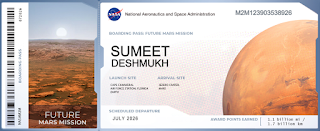Kids Activity- Send your name to Mars.

How to send your name to Mars ? Step 1 -Open Below Link https://mars.nasa.gov/participate/send-your-name/future Step 2- Fill out below details (1)First Name, (2)Last Name, (3)Country, (4)Postal code (5)Email Step 3- Click on "SEND MY NAME TO MARS" Button. Your Name will be stored on a micro-chip and this micro-chip is placed on the Rover. Once you have done above 3 steps, then view your "Boarding Pass" by visiting below website and filling out details ( same details you have mentioned in Step 2) https://mars.nasa.gov/participate/send-your-name/find Below is my Boarding Pass ! Below is translation of above text in Portuguese by Jessica(Dentist from Brazil,In Rio de Janeiro) Atividade para crianças - Envie seu nome para Marte Como enviar seu nome para Marte? Passo 1 - Abra o link abaixo https://mars.nasa.gov/participate/send-your-name/future Passo 2 - Preencha as informações abaixo (1)Nome (2)Sobrenome (3)País (4)Código Postal (5)E-mail Passo 3 - Clique no botão “...





